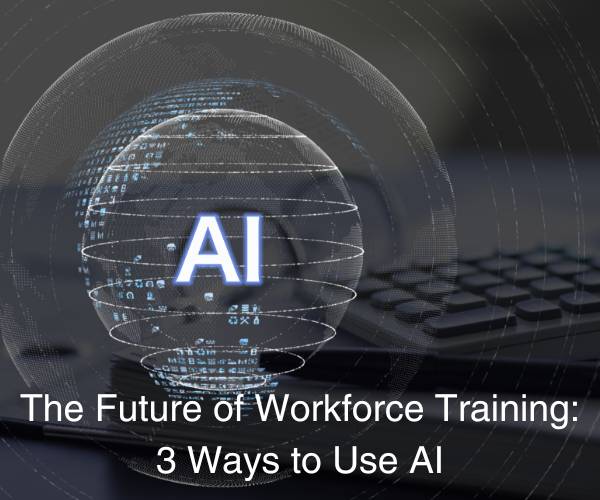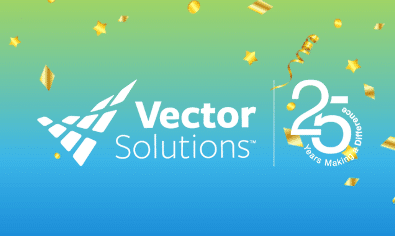March 11, 2025 5 min read

The Future of Workforce Training: 3 Ways to Use AI
Industry:
Solution:

Artificial Intelligence (AI) is transforming industries across the globe, and workplace training is no exception. At Vector Solutions, we are committed to equipping our everyday heroes—first responders, educators, industrial workers, and others—with the tools they need to work smarter, safer, and better. AI-powered tools must be part of that conversation, as they offer powerful opportunities to enhance learning, streamline workflows, and personalize career development.
Understanding AI’s Role in Workplace Training
Using AI in everyday life is no longer relegated to some future date – it’s already playing a key role in workplace learning. AI can significantly improve how organizations develop and deliver training to their valued workforce, from automating content creation to tailoring training based on individual needs.
1. AI-Powered Learning and Development
AI can help organizations and employers create and curate training content much faster. Rather than spending months or longer developing a specific course, AI-assisted course development tools can generate relevant learning objectives, training materials, and assessments faster than ever. This proactive approach allows businesses to keep up with evolving regulations, safety standards, and industry best practices.
However, the use of AI in course development is just one piece of the equation. It is important to note that qualified team members and subject matter experts should always be part of the process to ensure accuracy, compliance, and industry relevance.
2. AI for Global Training Accessibility
Ensuring that employees across the world receive high-quality training in their native language is essential for effective learning and compliance. AI-powered translation tools can streamline this process by quickly translating course content, subtitles, and assessments while maintaining clarity and intent.
However, simply using AI for translation is not sufficient. To develop truly effective translated training, organizations should do the following:
- Use AI-drive translations as a starting point, but have native-speaking experts review for cultural relevance and accuracy.
- Leverage AI tools that adapt translations based on industry-specific terminology, ensuring precise communication.
- Implement AI-powered voiceovers and subtitles to make learning more accessible for multilingual teams.
By integrating AI-powered translation with human oversight, companies can provide their global employees with exceptional training that is free from language barriers, helping to prevent accidents and injuries.
3. AI for Ongoing Career Development
Many organizations are now leveraging the power of AI to map out personalized career development paths and learning plans. By analyzing skills, job roles, and training histories, AI can recommend courses and certifications to help employees advance in their careers and achieve their personal goals – whether that means upskilling, reskilling, or preparing for leadership roles. By taking the growth potential of your employees seriously and investing in them, you are also much more likely to retain that employee and improve your general workplace morale.
Navigating AI Risks and Developing Effective Internal Policies
Although AI can be invaluable for your business, organizations must establish clear policies and procedures to ensure responsible and ethical use. Some key considerations include:
- Data Security & Privacy: AI systems process vast amounts of data, so it is critical to prioritize policies that protect employee and client data and organizational information. A recent incident involving the Chinese AI platform DeepSeek highlighted these concerns: a critical database leak exposed over one million records, including system logs, user prompts, and API tokens, underscoring the potential risks associated with AI data handling. Organizations should implement robust data encryption, access controls, and regular security audits to mitigate such risks. Clear policies must be in place to govern data collection, storage, and usage, ensuring compliance with data protection regulations.
- User Bias: AI is only as good as the data it’s trained on. Ensuring diverse and unbiased training data helps prevent discriminatory outcomes. For instance, an AI-driven career counseling tool designed to recommend management training candidates might be trained on historical employment data. If this data predominantly features profiles of successful managers who are white men, the AI could inadvertently learn and reinforce the pattern that ideal management candidates are white men, thereby creating disadvantages for equally qualified candidates from other demographics. By diversifying training data, conducting periodic evaluations of AI outputs to identify and correct biased recommendations or decisions, and involving diverse stakeholders in the development process, you can reduce the risk of embedding unconscious biases into the system.
- Transparency & Accountability: Employees must understand how AI is used in training and decision-making processes. Organizations should have clear accountability measures to avoid mistrust and effectively engage with AI-driven training programs. When AI generates learning paths, assessments, or career recommendations, learners need to know how those decisions are being reached. For instance, an AI-driven LMS that assigns mandatory safety training modules to employees based on their job roles and past assessment performance without clear transparency could make an employee feel unfairly singled out. A transparent AI system would provide explanations, such as explaining that someone demonstrated a knowledge gap in hazardous material handling or in another vital area. That is why organizations should clearly explain AI decisions, offer human oversight, and disclose AI’s role in learning.
Choosing the Right AI Platforms
With AI evolving so rapidly, many platforms are available to help organizations enhance training and productivity. Some common AI-powered tools include:
- LMS with AI Recommendations: Platforms that personalize learning and track progress.
- AI Writing & Content Creation: Tools that assist in generating training materials and reports.
- Chatbots & Virtual Assistants: Real-time learning support and the ability to respond to questions.
The Future of AI in Workplace Training
As the world continues to develop more AI tools, AI will play an even greater role in workplace training and professional development. The ability to create training content for many industries at scale, personalize learning, and increase global accessibility will enable companies to train their employees more efficiently – ultimately making workplaces more effective and productive.
By strategically embracing AI, savvy business leaders can enhance their training programs, empower employees, and build a smarter, safer workforce.









